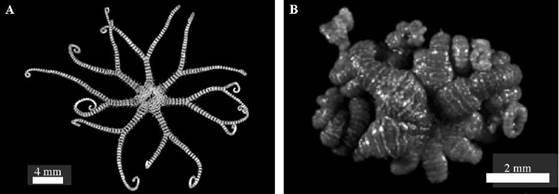Despite being the most diverse class of the phylum Echinodermata, Ophiuroidea has been one of the least studied groups in the Colombian Caribbean. From 1962 to 2011, 80 species of ophiuroids were reported from Colombia, including three species belonging to the family Gorgonocephalidae: Asteroporpa annulata Lütken 1856, Astrocnida isidis Duchassaing 1850, and Astrophyton muricatum Lamarck, 1816 (Thomas, 1962, 1965, 1973; Bayer et al„ 1970; Caicedo, 1979; Alvarez, 1980; Gallo, 1988; Hendler et al., 1995; Schoppe, 1996; Benavides y Borrero, 2000; González et al., 2002; Garcés y Romero, 2003; Alvarado, 2010; Benavides-Serrato et al, 2011). This family is characterized by having a large disk frequently covered with a thickened skin, which may possess various tubercles and granules; radial, bar-shaped shields extending from the center of the disc; usually spiny papillae on the jaw and arms that are branched or simple, covered with granules and distal with bands of small hooks (Paterson, 1985).
Schizostella bifurcata, also belonging to this family, is the only species currently accepted in its genus; the other described species, S. bayeri (A.H. Clark, 1952), was synonymized with S. bifurcata by Stóhr et al. (2016). In spite of the geographic range of this species presented by Pawson et al. (2009), which spans from the United States (Florida) to Colombia, there are a few records of this species along the Gulf of Mexico and the Caribbean Sea. In addition to Morant Cay, Jamaica, and Elliot Key, Florida, USA (Clark, 1952), apparently the only specific records of the species are based on Hendler et al. (1995), which includes Belize and Puerto Rico and represents the only records included in the most recent paper on the Caribbean and Latin America echinoderms (Alvarado, 2010; Alvarado and Solis-Marín, 2013; WoRMS, 2016). Despite these studies, this species was not included in the latest inventory of Colombian ophiurans and there is no biological material for this species available in Colombia.
Schizostella bifurcata commonly called "basket star", was found attached to gorgonian octocoral colonies in the area of El Morro in Santa Marta bay. Nine specimens were collected and detached from the colony without causing significant injuries. Individuals were relaxed with Epsom salt (magnesium sulfate) to extend their arms and then fixed in 70% ethanol. Animals were photographed and identified following the keys and descriptions by Hendler et al. (1995). Specimens were deposited in the Museum of Marine Natural History of Colombia (MHNMC) at Invemar (INV-EQU). With the report of this species, 81 species from this class have now been identified and inventoried for Colombia (Benavides-Serrato et al., 2011).
Schizostella bifurcata Clark, 1952 Fig. 1 A-B.
Identification references. A.H. Clark 1952: 452, pi. 40 (as S. bayeri);Hendler et al. (1995) (as S. bayeri and synonymized); Humman and DeLoach 2002:
Synonymy.Hendler et al. (1995)
Examined material. Nine specimens INV-EQU 2851, disk diameter 3.24.9 mm (11°15'0.95"N and 74°13'53.79"W).
Distinctive characters. Usually 4-mm in disk diameter, reddish, brown or pinkish-brown basket star, with seven short arms that usually branch near the middle region but sometimes branch in the terminal area. Its' base of the arms appears thickened and hardly distinguishable from the disc. The dorsal region of the disk presents rows of proximal hooks. White rings, formed by white granules, are restricted to both sides of each "annulus". These rings present dark and pigmented hooks, located in the dorsal region of the arm. Two hook-shaped spines form in the ventral region of the arm and appear in most segments of the arms. Low-scales are embedded in the integument covering the ventral surface of the disc and arms (Hendler et al., 1995). Schizostella bifurcata has multiple madreporites, the arms are clearly demarcated from the disc, and monticule of hooks on the basal branches are absent (although small individuals may have one or two hooks per segment).
Biology. This species is associated with gorgonians, which inhabit front-reef; thus, limiting its' distribution to depths of 12 to 46 m. During the day, individuals roll their arms in the octocoral branches, while at night this species extend its' arms are in a position for filtration similar to A. muricatum (Hendler et al., 1995). Clark (1952) speculated that S. bifurcata reproduces asexually by division through the disk; as a result, many individuals usually have big arms and several smaller arms in regeneration. This was confirmed by Hendler et al. (1995) who reported S. bifurcata as a fissiparous species. Specimens from Colombia were recorded on the continental shelf, associated to gorgonian colonies of Gorgonia ventalina and Euniceaflexuosa at 15 m depth in the exposed area of El Morro along the Santa Marta coast, where only two individuals showed arms in regeneration.
Distribution. Biscayne and Elliot Key, Florida, USA; Cayman Islands; Cozumel, Mexico; Puerto Rico; Barbados; and Belize at depths between 12 and 46 m (Hendler et al. 1995; Alvarado 2013), as well as Santa Marta, Colombia, at 15 m depth (present paper).
Comments. Variability in the branching patterns and number of arms as well as the organization of granules among different populations, led to the description of S. bayeri A.H. Clark, 1952, which is currently accepted as a junior synonym of S. bifurcata (Stohr et al., 2016). The specimens from Colombia have a brown color with 3.0 mm-disk diameters and lack differentiated arms.















